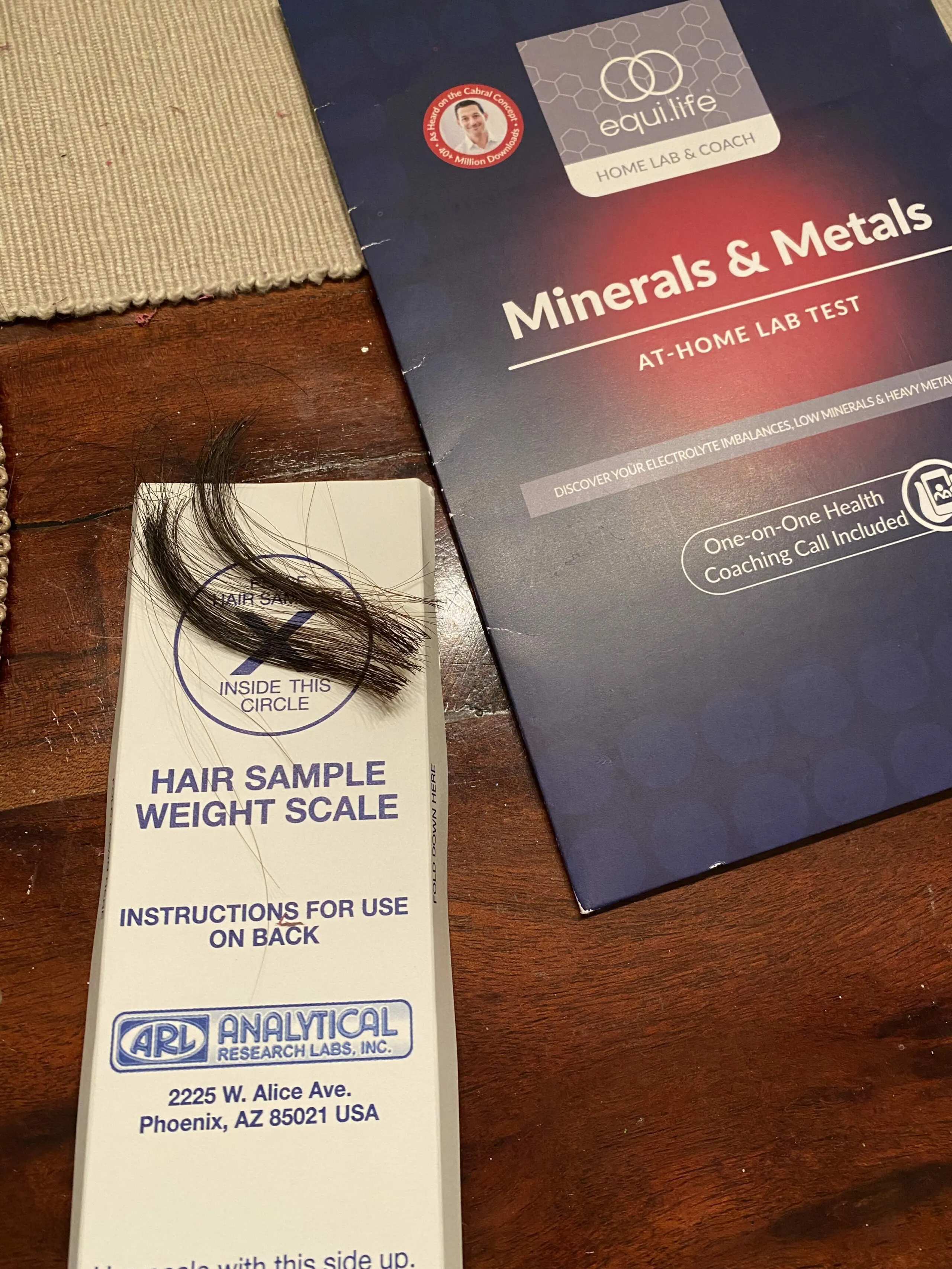
Sharing my experience with Hair Tissue Mineral Analysis and my results.
Hello friends! How are you? I hope you’re enjoying the day so far. Today is admin stuff, plus at-home strength training and breakfast for dinner tonight.
For today’s post I wanted to share my experience with HTMA as one of the testing tools I’ve been using. I shared more about my food sensitivity test here and will do another post about my Candida, metabolic, and vitamin testing. It’s been really amazing to gain insight into imbalances, especially with the eyes and the autoimmune things I experienced last year.
At first sight, HTMA It seems like a *simple* test, but there’s a lot it involves and a LOT it can tell you. It’s a snapshot of how your body responds to stress. When we’re stressed, we burn our minerals more quickly, which can leave us depleted and depleted. This can also be a very useful postpartum tool, as babies use the mother’s nutrients. Minerals work in pairs, so it is important to examine the relationships between minerals and try to find balance. There will never be a *perfect* HTMA test result; it’s more about seeing improvements in your body over time.

Embarking on a journey to understand your body’s unique needs and complexities is a powerful step toward holistic wellness. Today I am going to share with you what this test entails, its benefits, the process and my personal experience.
Note: This information is based on personal experience and education. Consult a healthcare professional for personalized advice. This test does not diagnose, prevent, treat or cure any disease or illness. It is simply an informational tool for your unique body.
Hair Tissue Mineral Analysis (HTMA) Test Review
What is HTMA and what can it tell you?
HTMA is a diagnostic tool that analyzes the mineral content in hair tissue. Since our hair reflects our body’s mineral composition, this non-invasive test offers a window into mineral imbalances, heavy metal exposure, and possible nutritional deficiencies from the past 90 days. It goes beyond surface symptoms and can help uncover the root causes of various health problems. Minerals are essential for our entire body and are the “spark plugs”.
Pros and benefits:
HTMA provides a holistic perspective on your mineral status, assisting in the identification of imbalances that may contribute to health problems. It can also provide information about your nervous system, adrenal function, thyroid function, and absorption.
Early Detection: Early detection of mineral imbalances allows for proactive adjustments to prevent potential health problems.
Personalized Nutrition: With insights from HTMA, personalized nutrition plans can be designed to address specific deficiencies and promote overall well-being.
Cons:
External contamination: External factors such as hair products or environmental exposure can influence test results. Choosing a reputable laboratory and following pre-testing guidelines mitigates this concern.
How to perform the test:
Order Kit – Select a trusted HTMA supplier and order your kit. (I work with clients with trial only packagesand as part of 1:1 training.)
Collect a hair sample: Follow the instructions on the kit to collect a hair sample from the back of your head, closer to the scalp. You don’t need a ton of hair; It is about a tablespoon. The test kit comes with a paper scale to ensure you have enough.
Send to laboratory: Send the sample to the designated laboratory for analysis.
Here’s my proof: I did a full breakdown of the results on IG.

Who can benefit from HTMA?
Chronic health problems:
People experiencing persistent health problems may benefit from uncovering underlying mineral imbalances.
Athletes:
Optimizing mineral levels is crucial for athletes looking to improve performance and recovery.
Preventive Health:
Proactively addressing potential imbalances can potentially prevent future health problems.

The breakdown of HTMA results:
HTMA results offer a complete analysis of various minerals and heavy metals in your body. Key minerals include magnesium, calcium, potassium, sodium and trace elements such as zinc and copper. Elevated or depleted levels of these minerals can provide information about possible health problems.
Understanding mineral imbalances:
Magnesium: Deficiency can contribute to muscle cramps, anxiety and fatigue.
Calcium: Elevated levels can affect cardiovascular health and bone density.
Zinc: a mineral crucial for immune function; Deficiency can affect wound healing and immunity.
Copper: Imbalances can influence energy levels and contribute to hormonal problems.
Interpretation of heavy metal exposure:
HTMA also assesses exposure to heavy metals such as lead, mercury, aluminum, and cadmium. Elevated levels may indicate environmental exposure or impaired detoxification pathways.
Hair tissue mineral analysis (HTMA) classifies individuals into different metabolic types based on their oxidation rate. This rate, commonly known as metabolic type, classifies people into fast oxidants, slow oxidants, or mixed oxidants.
Here is a very brief description of each one:
Fast Oxidizers:
Metabolic characteristics: Fast oxidizers have a fast oxidation rate, meaning their bodies process nutrients quickly.
Common traits: They may experience bursts of energy followed by fatigue, have difficulty maintaining weight, and often crave sweets.
Nutritional recommendations: Fast oxidizers may benefit from a diet rich in complex carbohydrates, moderate protein, and healthy fats to help stabilize blood sugar levels.
Slow oxidizers:
Metabolic characteristics: Slow oxidizers have a slower oxidation rate, meaning their bodies metabolize nutrients at a more gradual rate.
Common traits: They may have problems with lack of energy, weight gain, and experience cravings for stimulants such as caffeine.
Nutritional recommendations: Slow oxidizers may benefit from a diet that emphasizes lean proteins, complex carbohydrates, and moderate healthy fats to support sustained energy levels. Mixed oxidants:
Metabolic characteristics:
Mixed oxidants exhibit characteristics of fast and slow oxidants, showing a balance between fast and slow metabolic rates.
Common traits: They may experience a combination of fast and slow oxidant symptoms, making their nutritional needs a little more nuanced.
Nutritional recommendations: Mixed oxidants benefit from a balanced diet that incorporates elements of the fast and slow oxidant dietary recommendations.
My personal experience:
having suffered HTMA, I discovered valuable information about my mineral status. The test identified areas for improvement, guiding me towards specific dietary adjustments and supplements. While not a standalone solution, HTMA serves as a powerful tool in my journey toward holistic health. (My food sensitivity and OAT tests were also extremely revealing!)
If you are curious about any functional tests, send me an email at gina@fitnessista.com with the subject TESTS
It makes a big difference to take the supplements your body needs, rather than the ones you think you *should* take (which can even cause negative effects). New 1:1 clients who sign up for a 3-month package will receive a free HTMA and Candida, Metabolic and Mineral test ($499 value).
Have a wonderful day and see you soon!
hugs and kisses
gina







